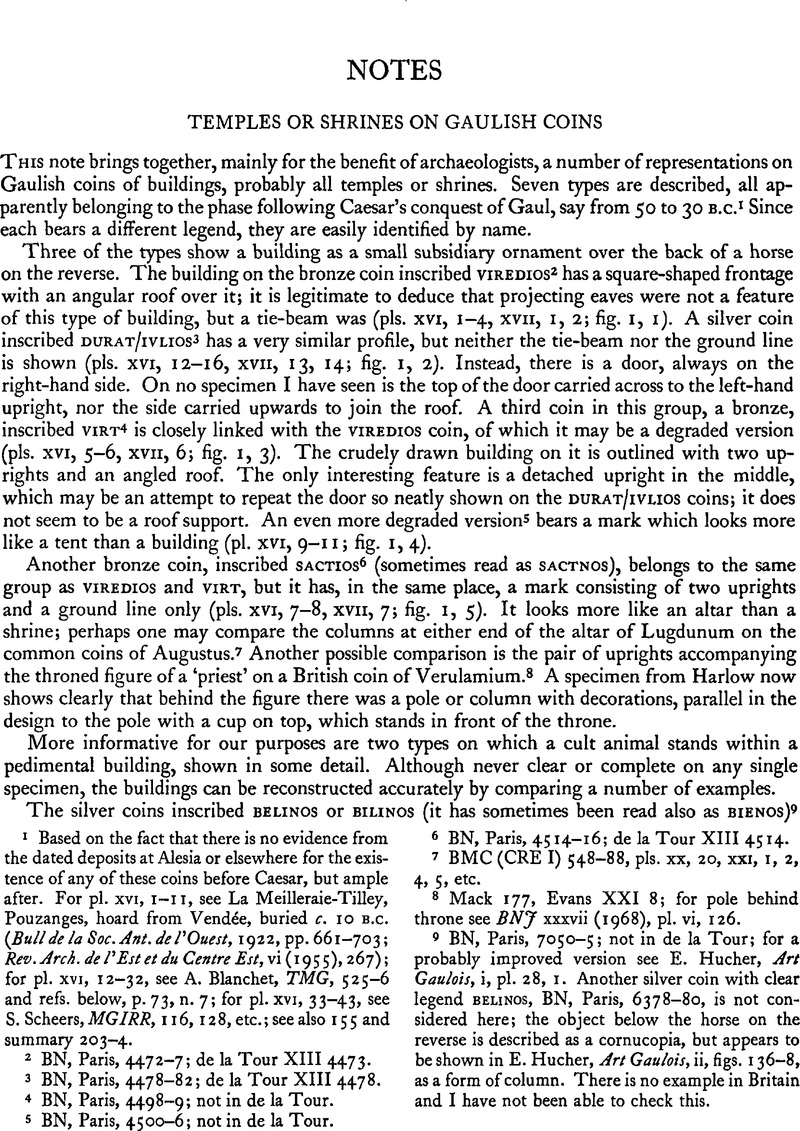Article contents
Temples or Shrines on Gaulish Coins
Published online by Cambridge University Press: 29 November 2011
Abstract

- Type
- Notes
- Information
- Copyright
- Copyright © The Society of Antiquaries of London 1973
References
page 71 note 1 Based on the fact that there is no evidence from the dated deposits at Alesia or elsewhere for the existence of any of these coins before Caesar, but ample after. For pl. XVI, i-n, see La Meilleraie-Tilley, Pouzanges, hoard from Vendée, buried c. 10 B.C. (Bull de la Soc. Ant. de I'Ouest, 1922, pp. 661–703; Rev. Arch, de I'Est et du Centre Est, vi (1955), 267Google Scholar); for pl. XVI, 12–32, see A. Blanchet, TMG, 525–6 and refs. below, p. 73, n. 7; for pl. XVI, 33–43, see S. Scheers, MGIRR, 116, 128, etc.; see also 155 and summary 203–4.
page 71 note 2 BN, Paris, 4472–7; de la Tour XIII 4473.
page 71 note 3 BN, Paris, 4478–82; de la Tour XIII 4478.
page 71 note 4 BN, Paris, 4498–9; not in de la Tour.
page 71 note 5 BN, Paris, 4500–6; not in de la Tour.
page 71 note 6 BN, Paris, 4514–16; de la Tour XIII 4514.
page 71 note 7 BMC (CRE I) 548–88, pls. xx, 20, xxi, 1, 2, 4, 5, etc.
page 71 note 8 Mack 177, Evans XXI 8; for pole behind throne see BNJ xxxvii (1968), pl. vi, 126Google Scholar.
page 71 note 9 BN, Paris, 7050–5; not in de la Tour; for a probably improved version see Hucher, E., Art Gaulois, i, pl. 28, 1Google Scholar. Another silver coin with clear legend belinos, BN, Paris, 6378–80, is not considered here; the object below the horse on the reverse is described as a cornucopia, but appears to be shown in Hucher, E., Art Gaulois, ii, figs. 136–8, as a form of columnGoogle Scholar. There is no example in Britain and I have not been able to check this.
page 72 note 1 BMC (CRR I) 3815; E. Sydenham, RRC, 878; plated.
page 72 note 2 The carnyx takes two forms. On coins where the architrave is present, the goat head has two horns and the instrument is, as usual, segmented; on coins without an architrave, the forms are more rounded, the ears less prominent, and the segmentation less marked.
page 72 note 3 The form of sceptre resembles that carried by the rider on de la Tour L 9782 (Pink, MOK 129–30), which is seen as a separate emblem on e.g. de la Tour VI 2630, XVII 5836, XXXVIII 9000–13, and in Britain on gold staters of the Dobunni, etc.
page 72 note 4 BN, Paris, 7100–10; de la Tour XXVIII 7100.
page 72 note 5 De la Tour XXVIII 7056, 7058, 7064, 7070, 7078, 7081, 7095/6, 7100, 7105; Blanchet, TMG, figs. 266–74. A tenth typein Ogam, vi (1954), 298Google Scholar.
page 73 note 1 BN, Paris, 7370–1; de la Tour XXX 7370.
page 73 note 2 De la Tour XXIX 7356, 7357, 7360, 7363, XXX, 7367, 7370, 7372; legends svticcos velio-caөi, svticos, svticos ratvmacos, ratvmacos.
page 73 note 3 BMC (CRE I), pls. v, 20, vi, 9, VII 14–20, VIII 10–14, XV, 14, XXXIV, 4, XL, 10–13, LI, 22, etc.
page 73 note 4 A. Blanchet, TMG, 297–8.
page 73 note 5 Caesar, , BG viii, 26, 27Google Scholar.
page 73 note 6 Collection Latomus, lviii (1962), 431–2Google Scholar.
page 73 note 7 Blanchet, A., TMG, 525–6; Num. Chron. 1968, pp. 52–3;Google ScholarArchaeologia, civ (1971), 26–9Google Scholar.
page 73 note 8 S. Scheers, MGIRR, pp. 154–5, map 41.
page 73 note 9 Ibid., pp. 124–8, map 23.
page 73 note 10 Ibid., pp. 115–16; maps 16–18.
- 1
- Cited by


